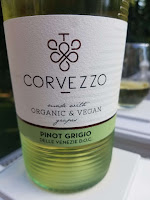"Regenerative organic agriculture is a collection of practices that focus on regenerating soil health and the full farm ecosystem. In practice, regenerative organic agriculture can look like cover cropping, crop rotation, low- to no-till, compost, and zero use of persistent chemical pesticides and fertilizers. Layered into these practices, depending on a farm’s needs, could be the addition of perennials, development of pollinator and wildlife habitats, incorporation of agroforestry systems, vegetative barriers, and other regenerative practices that are shown to contribute to the development of soil organic matter."
Regenerative Farming is a contemporary topic where and increasing number of agriculture entities are following these practices.
Domaine Bousquet was the first wine estate out of the United States (4th overall) to achieve
Regenerative Organic Certified (ROC)™ status. Their vineyards (first planted in 1997-98) are situated high above the clouds at 4,000 feet in Gualtallary in Mendoza’s Uco Valley. This dry environment definitely helped achieve many aspects of this status, but they also had to implicitly institute policies and procedures to "rehabilitate soil, respect animal welfare, and improve the lives of farmers and farm workers".
The first tenant of regenerative farming is No-Till Farming. This method offers a range of benefits that can improve soil health, increase crop yields, reduce environmental impacts, and save farmers money. No-till farming educes soil erosion, preserves soil structure, increases soil organic matter, and reduces soil compaction, leading to better soil biological activity and improved soil health. Fields managed using no-till farming for multiple years have a higher water-holding capacity. And farmers benefit from reduces fuel and labor costs.
Grapes for the
GAIA label have always been grown organically and the "Greek goddess of the earth, has been the Bousquet family’s inspiration since founding our winery 1997". The grapes for this brand come from the estate vineyards in Tupungato, Alto Gualtallary -- located at the foothills of the Andes at 4,000 ft. altitude. This location provides intense sun exposure and huge shifts in day-to-night temperatures combine to both mature the grapes and retain acidity. The
Gaia Organic Pinot Noir Rosé exudes red berries both on the nose and its creamy palate. Expect racy acidity for a refreshing pale rosé.
The next tenant of regenerative farming is Biodiversity through at least four plant groups. This process increases pollinator populations by providing diverse flower-rich habitats and reduced pesticide use support pollinators like bees, butterflies, and hummingbirds. It enhances ecosystem services so that soil biota, decomposers, and predators work together to regulate pests and diseases, reducing the need for chemical controls. Biodiversity improves habitat connectivity as regenerative farms with diverse habitats and corridors can support wider species distributions and population growth. And is sequesters carbon as healthy soils and diverse ecosystems help sequester carbon, mitigating climate change and its impacts on biodiversity.
The Gaia Organic Malbec 2022 spends between eight and ten months in French oak providing complimentary vanilla tannins to the juicy ripe blackberry notes. This is an extremely approachable wine with a touch of spice to liven the glass.
The third tenant of regenerative farming is planting
Cover Crops that become layers of armor by protecting the soil from sunlight and maintains moisture. Regenerative farming and cover crops are intertwined concepts that promote soil health, biodiversity, and ecosystem services. Regenerative agriculture focuses on enhancing natural processes to improve soil fertility, structure, and overall ecosystem function. Cover crops play a vital role in this approach, serving as a bridge between cash crops and soil regeneration.'
The fourth tenant of regenerative farming is incorporating Animals as a key component to achieve the regenerative goals. This includes grazing management emphasizing rotational grazing, where animals are moved to different pastures to mimic natural grazing patterns. This approach promotes soil health, increases biodiversity, and sequesters carbon. Manure is used as a natural fertilizer, reducing the need for synthetic fertilizers and minimizing carbon emissions associated with their production and transportation. Animals like chickens, ducks, and geese can be used as natural pest managers, reducing the need for pesticides and promoting soil health. Holistic approach: Regenerative farming recognizes the interconnectedness of soil, plants, animals, and ecosystem services. By incorporating animals into the farming system, farmers can create a more resilient and diverse ecosystem.
Like the Malbec, the Gaia Organic Cabernet Sauvignon 2022 ages between eight and ten months in French oak. In contrast, there is more intense dark cherry notes with saline flowing through the soft finish.
The fifth and final tenant of regenerative farming is instituting Labor Practices that ensure sufficient wages and worker safety. Regenerative farmers prioritize fair labor practices, ensuring decent working conditions, safe working environments, and equitable compensation for farmworkers. Regenerative agriculture values the dignity and well-being of farmers and farmworkers, recognizing their importance in maintaining healthy ecosystems and producing nutritious food. Regenerative farms strive to provide comfortable and safe working conditions, including adequate shade, ventilation, and access to clean water and sanitation facilities. Regenerative farmers avoid using synthetic pesticides, herbicides, and fertilizers, reducing exposure risks for farmworkers and promoting a healthier environment. Regenerative agriculture often involves community-based approaches, fostering relationships between farmers, farmworkers, and local communities to promote social and environmental sustainability. Regenerative farmers invest in training and capacity-building programs for farmworkers, enhancing their skills and knowledge in sustainable agriculture practices. Regenerative practices like agroforestry, cover cropping, and crop rotation can reduce labor requirements, improving working conditions and reducing the risk of labor exploitation. Regenerative farmers prioritize continuous learning and improvement, adapting to changing environmental and social conditions while refining their labor practices to ensure long-term sustainability.




























